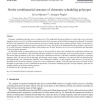Free Online Productivity Tools
i2Speak
i2Symbol
i2OCR
iTex2Img
iWeb2Print
iWeb2Shot
i2Type
iPdf2Split
iPdf2Merge
i2Bopomofo
i2Arabic
i2Style
i2Image
i2PDF
iLatex2Rtf
Sci2ools
DAM
2006
2006
On the combinatorial structure of chromatic scheduling polytopes
Chromatic scheduling polytopes arise as solution sets of the bandwidth allocation problem in certain radio access networks, supplyingwirelessaccesstovoice/datacommunicationnetworksforcustomerswithindividualcommunicationdemands.Tomaintain the links, only frequencies from a certain spectrum can be used, which typically causes capacity problems. Hence it is necessary to reuse frequencies but no interference must be caused by this reuse. This leads to the bandwidth allocation problem, a special case of so-called chromatic scheduling problems. Both problems are NP-hard, and there do not even exist polynomial time algorithms with a fixed quality guarantee. As algorithms based on cutting planes have shown to be successful for many other combinatorial optimization problems, the goal is to apply such methods to the bandwidth allocation problem. For that, knowledge on the associated polytopes is required. The present paper contributes to this issue, exploring the combinatorial structure of chro...
| Added | 11 Dec 2010 |
| Updated | 11 Dec 2010 |
| Type | Journal |
| Year | 2006 |
| Where | DAM |
| Authors | Javier Marenco, Annegret Wagler |
Comments (0)

